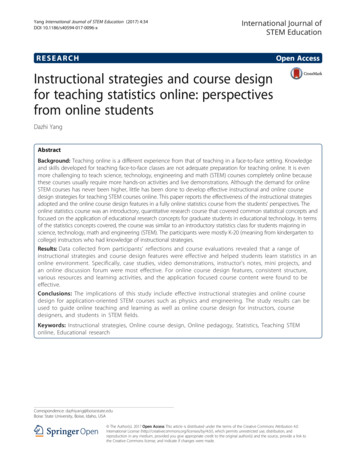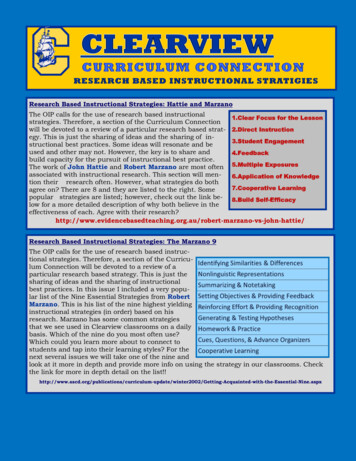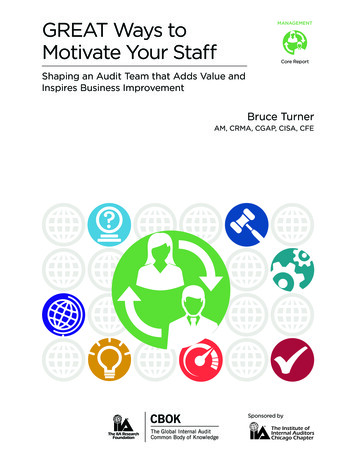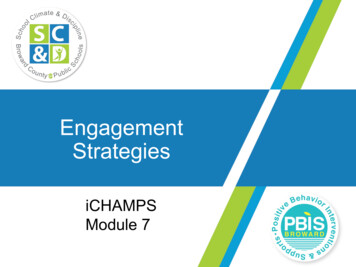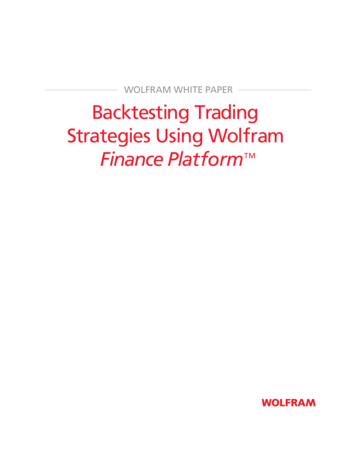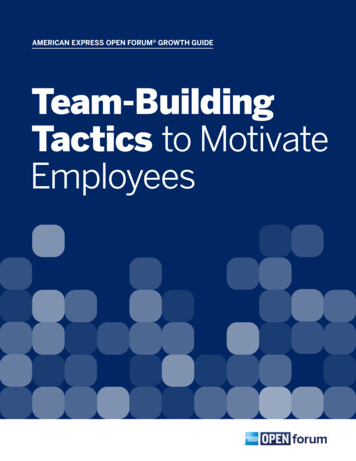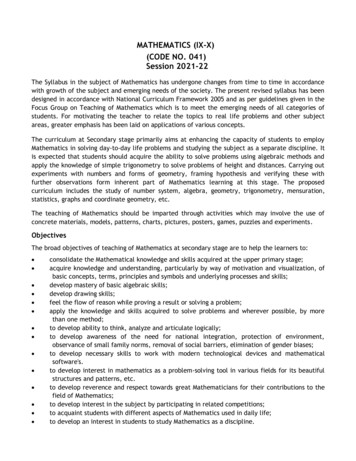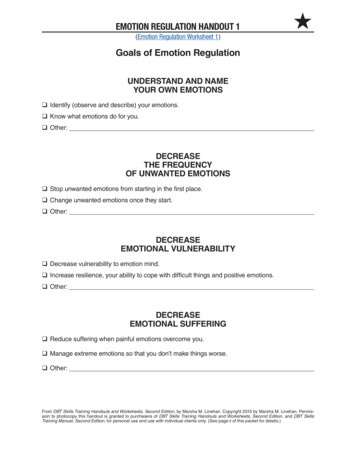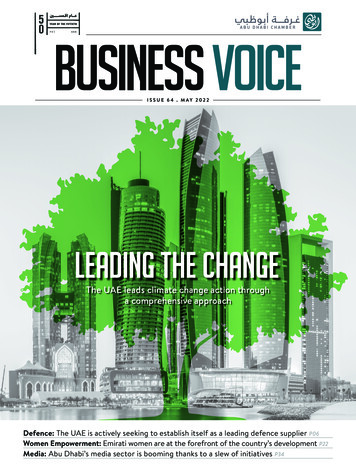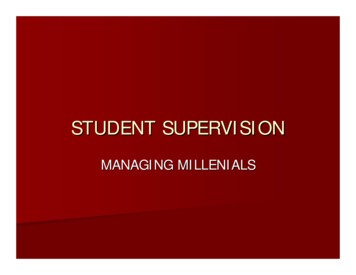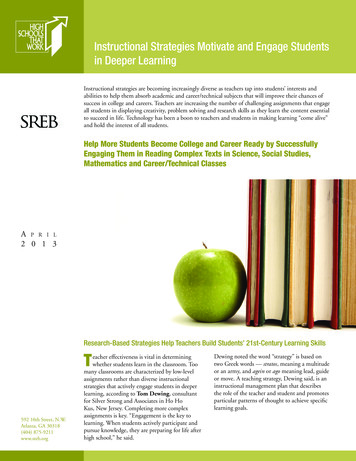
Transcription
Instructional Strategies Motivate and Engage Studentsin Deeper LearningInstructional strategies are becoming increasingly diverse as teachers tap into students’ interests andabilities to help them absorb academic and career/technical subjects that will improve their chances ofsuccess in college and careers. Teachers are increasing the number of challenging assignments that engageall students in displaying creativity, problem solving and research skills as they learn the content essentialto succeed in life. Technology has been a boon to teachers and students in making learning “come alive”and hold the interest of all students.Help More Students Become College and Career Ready by SuccessfullyEngaging Them in Reading Complex Texts in Science, Social Studies,Mathematics and Career/Technical ClassesA P R I L2 0 1 3Research-Based Strategies Help Teachers Build Students’ 21st-Century Learning SkillsT592 10th Street, N.W.Atlanta, GA 30318(404) 875-9211www.sreb.orgeacher effectiveness is vital in determiningwhether students learn in the classroom. Toomany classrooms are characterized by low-levelassignments rather than diverse instructionalstrategies that actively engage students in deeperlearning, according to Tom Dewing, consultantfor Silver Strong and Associates in Ho HoKus, New Jersey. Completing more complexassignments is key. “Engagement is the key tolearning. When students actively participate andpursue knowledge, they are preparing for life afterhigh school,” he said.Dewing noted the word “strategy” is based ontwo Greek words — stratos, meaning a multitudeor an army, and agein or ago meaning lead, guideor move. A teaching strategy, Dewing said, is aninstructional management plan that describesthe role of the teacher and student and promotesparticular patterns of thought to achieve specificlearning goals.
Types of Engagement Integrate research skills across standards and grades.Engagement types include intellectual, social, emotional andbehavioral. “Students understand how teachers relate to thesubject matter,” Dewing said. “If a teacher is passionate andknowledgeable about a subject, students will respond withenthusiasm and interest.” Write to argue, inform and explain to prepare students forcollege-level assignments.Dewing points to the “knowing-doing gap” as the biggesthurdle for any school or teacher in enhancing learning forstudents. “Teachers must find a way to bridge the gap betweenwhat they know about good instruction and what they do inthe classroom,” Dewing said. “The degree to which teachersare able to implement best practices in the classroom in athoughtful, meaningful way determines the performance of aschool or a student.”“Promoting literacy is a shared responsibility for all contentteachers, not just English/language arts teachers,” Dewing said.Literacy plays an important role in teaching and learning math,science, history, art and career/technical studies.Teachers can improve students’ reading and writing skills bygetting them to read for meaning: Give students a list of “agree or disagree statements” aboutassigned texts. Ask students to preview the statements and begin readingthe text.To overcome the “knowing-doing gap,” Dewing said educatorsmust understand clearly what the Common Core StateStandards (CCSS) and other rigorous standards are askingeducators and students to do. Ask students to indicate whether they agree or disagree withthe statements based on what they read. Have students justify their agree/disagree positions by citingappropriate evidence from the text.According to its mission statement, the CCSS initiative aimsto “provide a consistent, clear understanding of what students areexpected to learn, so teachers and parents know what they need to doto help them. The standards are designed to be robust and relevantto the real world, reflecting the knowledge and skills that ouryoung people need for success in college and careers. With Americanstudents fully prepared for the future, our communities will be bestpositioned to compete successfully in the global economy.”“Applying the rigorous strategies outlined in the CCSS in allschool subjects not only will improve the learning experiences ofstudents in the middle grades and high school but will providea strong foundation on which to pursue their aspirations aftergraduation,” Dewing said.Lively ClassroomsOne major way to accomplish a lively classroom with hands-onlearning is to enhance literacy: Emphasize teaching the reading of informational texts. Steadily increase the ability of students to understand morecomplex materials over time.Dewing is co-author with Harvey Silver and Matthew Perini ofThe Core Six: Essential Strategies for Achieving Excellence with theCommon Core. “The book is designed to help teachers look atthe Common Core State Standards and implement six strategiesthat teach to the common threads that the standards are askingto be implemented,” Dewing said.Tom Dewing: rthomasdewing@gmail.comThe Sweet Spot of Engagement Boosts Student LearningIt is important for teachers to find the “sweet spot” for engaging all students in learning, according to Steve Barkley, executive vicepresident of Performance Learning Systems, Inc., in Madison, Georgia. At the same time, he acknowledges that competition forstudent engagement has changed over the years. “Many students today enter the classroom from the real world where they engagewith electronic gadgetry, sports activities and other events.”Barkley suggests placing emotion and engagement on a continuum that begins with “fear” and ends with “bored.” Learning isminimized at both ends of the scale, he said.FearAttentionComfortBored“We need to eliminate school and classroom cultures based on fear, where students experience threats, embarrassment and/orviolence and where learning is secondary to safety,” Barkley said. “However, when students exhibit characteristics of boredom,teachers need to raise the anxiety level by increasing requirements through additional rigor or depth of learning. If students begin toshow anxiety, the teacher must reduce that feeling. One way is for students to complete challenging assignments by working togetherin pairs or groups.”2
Barkley said the ideal emotional learning spot — the sweet spot — lies between “fear” and “attention.” Tutoring pays offbecause effective tutors hold students in that position. “If tutors see students getting comfortable with learning, they continue,”Barkley said. “If they see students getting anxious, they give more practice.”Master teachers monitor constantly to sense when students are moving from the sweet spot of attention to the comfort spot; thenthey take action to bring students back to the high side of attention. Barkley said teachers must know their students and be skilled atadjusting the pace, assignments and strategies to maximize learning.Barkley shared five types of engagement as described by author Phil Schlechty: Engagement — Students are attentive and focused on the task with commitment and persistence; they volunteer personalresources of time, effort and attention. Strategic Engagement — Students are willing to do the work as long as extrinsic rewards are present. Remove the reward (grades)and students withdraw their effort. Students in this case ask, “Will this be graded?” “How many points?” “Does this count?” Ritual Compliance — Students want assurance that what they do will pay off in grades and improved chances for college.This scenario generally requires supervision. Producing the work with minimal effort could mean copying work or cheating onan exam. “Retreatism” — This action manifests lack of compliance in passive ways, such as withdrawing from a task. If challenged,students may move to compliance or rebellion. Teachers often overlook retreatism. Rebellion — This action focuses attention on something else and often is seen as disruptive.The five types of engagement can be related on the emotional continuum with engaged learning occurring at the sweet spot.“Behavioral engagement is when students exhibit on-task behaviors, including persistence with challenging tasks, asking questionsand requesting help,” Barkley said. “Intellectual engagement is deep involvement and effort by students to understand a concept ormaster a skill. Emotional engagement is when students exhibit high interest, a positive attitude, curiosity and task involvement.”Barkley emphasized that people desire or volunteer to do things because they matter and are interesting. He said the goal ofSweet SpotFearAttentionComfortBorededucation is to create self-direction in students. “It is essential to design instruction that helps students connect with learning whiledeveloping autonomy, mastery and purpose,” Barkley said.In a survey conducted by Vito Perrone, former professor at the Harvard Graduate School of Education, students reported that theywere most engaged intellectually when involved in defining learning content, when they had time to wonder and find a particulardirection that interested them and when topics had a “strange” quality — something common viewed in a new way, evoking aquestion.How can a teacher who is required to teach standards maintain control and autonomy in the classroom? Barkley suggestedteachers need to connect real life to the content being taught to get the emotional engagement that draws students tolearning. He encouraged teachers to find the sweet spot of student engagement to be successful in preparing students for furthereducation and careers.Steve Barkley: lmalanowski@plsweb.com3
Challenging Students to Read More in Literature and History ClassesTwo teachers and a librarian at Monarch High School(MHS) in Louisville, Colorado, challenged students inliterature and history classes to read 2,500 pages during the2011-2012 school year. The challenge was successful and yieldedpositive changes in students’ attitudes toward reading.The idea to promote reading at MHS originated with Americanhistory teacher Deann Bucher after attending the HSTW StaffDevelopment Conference in summer 2011. “I learned thatstudents perform better in all content areas when they readmore,” Bucher said. “Some schools have seen as much as a oneyear growth in reading when students read the equivalent of25 books per year outside of class.”The Reading Challenge team launched the program by surveyingstudents to determine individual attitudes about reading. “To getbetter at reading, you need to practice,” Barnes told The BoulderDaily Camera in Boulder, Colorado. “You’re not going to practicesomething you hate.”Book Lovers or HatersUsing data from the survey, the team ranked students as“reading lovers,” “neutrals” and “reading haters.” Gerrish tookresponsibility for working with the reading haters. She met withthem individually and in groups to help them find books andmagazines of interest. She also taught students to use the libraryas a resource. “I lowered some of the library’s restrictions ondue dates, fees and access times so that students would be morecomfortable with the checkout process,” Gerrish said.Needing to increase the library’s collection of books to servestudents better, Gerrish applied for and received a 1,500 grantfrom the Parent Teacher Student Organization. She combinedthat amount with her library budget of 1,000, a sum of 1,200 from the Impact on Education Foundation and 400from the district office. The money was used to purchase Nooke-readers, iPod portable media players, special-interest booksand magazines, plus Reading Challenge t-shirts.“I enjoyed many new books I never would havethought to read.” “I rediscovered the joy ofreading.”Students, Monarch High SchoolMHS is a highly successful school for most students, Bucherexplained, but some students do not reach their potential. “Ineeded ways to raise student achievement, and I realized that theanswer was to increase students’ abilities to engage with texts,”she said.Launching the ChallengeBucher met with American literature teacher Mystayn Barnesand librarian Beatrice Gerrish. The result was the challengeto read 2,500 pages. Of those pages, 100 would be by a worldauthor and another 100 would be nonfiction. Students wouldwrite summaries of their reading and post information onEdmodo, a secure social learning network for teachers andstudents.In the first year, 150 students participated from one history class(taught by Bucher) and two literature classes (taught by Barnes).In 2012-2013, most history students, along with students inliterature classes, are participating in an expanded program.“We wanted students to read more and enjoy it,” Bucher said.“We started with the belief that if students read more they willraise their reading scores and across-the-board achievement.”4Best-Liked BooksThe reading haters found the following books mostinteresting: The Hunger Games series by Suzanne Collins;The Maze Runner trilogy by James Dashner; Before I Fall byLauren Oliver; Into Thin Air and Into the Wild, both by JonKrakauer; and the Rot & Ruin series by Jonathan Maberry.“Loading books on Nooks and iPods made them moreapproachable for many students,” Gerrish said.Parents indicate that the library expenditure for the ReadingChallenge was a good investment in bringing about positivechanges in students. Gerrish said one mother “shed tears ofjoy” that her popular son, a star football player, stayed home toread using his Nook. Another parent emailed the school, “Weare experiencing amazing progress with our son. He was nevera reader. When I heard about the reading goal at school, I wasreally worried. Now, it’s as though something clicked. It’s aparent’s dream.”Positive Responses From StudentsStudents’ responses were positive. One student said it was“cool” to read. Others arrived at class early to read and askedfor more in-class reading time. Students participated withteachers in spontaneous book discussions, traded books withone another and encouraged classmates to read. One studentsaid: “I enjoyed many new books I never would have thoughtto read.” Another said, “I rediscovered the joy of reading.”
The Reading Challenge team conducted a survey to measurethe success of the project. “When we began the challenge,we had one goal — intellectual engagement,” Gerrish said.“We discovered that the challenge resulted in unexpectedimprovement in social, emotional and behavioral engagement.”“Perhaps the most impressive figure of all is that the studentsof just two teachers — Bucher and Barnes — read a total of384,581 pages of text during one school year,” Gerrish said.More than 60 percent of students said they read zero to onehour a week before the challenge. By the end of the year, thatpercentage had dropped to 20 percent. Fifteen percent ofstudents were reading as many as five hours per week by the endof the year. In addition, 43 percent of students reported beingbetter readers and 58 percent said they would continue readingduring the summer.Deann Bucher: dean.bucher@bvsd.orgMystayn Barnes: mystayn.barnes@bvsd.orgBeatrice Gerrish: beatrice.gerrish@bvsd.orgGot Rigor? One School Increases Mathematics Achievement“You have to be willing to put yourself out there and try something new,” according to Andrea Richardson, math departmentco-chair at Farmington High School (FHS) in Farmington, Missouri. FHS is an hour south of St. Louis in a city with apopulation of just over 16,000. Forty-three percent of students are eligible for free or reduced-price lunches.“Faculty and staff knew we had to do just that if we wanted to increase student achievement in math and decrease the number ofstudents taking remedial math in college, Richardson said” The result is an innovative math course sequence. The sequence courses areAlgebra 1, Algebra 1.5, Algebra 2, Algebra 2.5, College Algebra, Informal Geometry, Formal Geometry, Probability and Statistics 1,Probability and Statistics 2, College Trigonometry, College Pre-Calculus, and College Calculus.New Math ClassIn 2008 the school created a new math class known as Algebra 1.5 to serve as a bridge between Algebra 1 and Algebra 2 for studentsnot quite ready for Algebra 2. In conjunction with Algebra 1 and geometry, the new course is designed to keep struggling students onschedule for graduation.FHS has continued to offer a nontraditional path for math students. Those who do not score well on the ACT or the Compassassessment can take Algebra 2.5. Taught like an intermediate college algebra course, it is intended to keep students from taking aremedial math class in college. For non-struggling students, FHS offers dual credit courses in college algebra, trigonometry, pre-calculusand calculus.As the Common Core State Standards (CCSS) are implemented, FHS will require all students to take a one-semester coursetitled Probability and Statistics 1. “We decided it would be best for students if we took the statistics standards out of the CCSSrecommended Algebra 1, geometry and advanced algebra curriculum and taught it in one course,” said Jane Harris, mathdepartment co-chair. “This is part of fulfilling the math department’s goal of doing what is best for students.”Supporting StudentsFHS offers a variety of student supports beyond the new class offerings. They include ACT bell ringers, before- and after-schooltutoring, common assessments, Moodle sites set up to support students with resources, classrooms designed for students to sit ingroups of two to four for daily cooperative peer support, and Cornell Notes. Teachers use formative assessment strategies such as exitslips to serve their students better. Students also have access to a wide range of technology such as classroom computers, graphingcalculators and geometric software.Leaders and teachers at FHS determined these student supports would not be enough to meet their goals. “We knew we needed tofocus on teachers in order to help students,” Richardson said. Each new teacher has a mentor teacher for two years. Teachers usecollaborative planning time to review benchmark data, modify curriculum plans as needed, create common assessments, share successesand learn more about implementing different technologies.FHS has found success in this journey of nontraditional teaching. Failure rates for freshmen in Algebra 1 decreased from 18.5 percentin 2009 to 14 percent in 2012. The percentage of college freshmen who graduated from FHS and took remedial math classesdeclined from 22.9 percent in 2006 to 14.2 percent in 2010.5
The school has experienced growth in other areas: The graduation rate increased from 59.8 percent in 2006 to 75 percent in 2012 — 3.5 percentage points above the state average. A total of 138 students completed 380 dual credit classes in 2007. The total rose to 282 students completing just over 900 dualcredit or dual enrollment classes in 2012. The daily attendance rate rose from 91.9 percent in 2007 to 94.1 percent in 2012.For schools considering a nontraditional approach for students, Richardson and Harris offered this advice:1. All staff members must set high expectations for students.2. Students need to believe they can be successful. FHS uses mastery learning, positive relationships and an effort-based system thatallows students to redo assignments rather than receive a grade of F. Teachers do not accept zeros or no effort.3. Teachers must keep an open mind and be willing to try new strategies.4. Administrators need to be flexible and supportive of teachers, including coordinating professional development opportunities.5. Teachers and administrators alike must remember that the evaluative process never ends.Jane Harris: jharris@farmington.k12.mo.usAndrea Richardson: arichardson@farmington.k12.mo.usTeacher Uses Engaging Literacy Strategies to Motivate Students to AchieveCyndie Wilkins, a family and consumer sciencesteacher at Fairhope Middle School in Fairhope,Alabama, encourages teachers to become “stars” in theirown classrooms. For example, she pedals into the roomon a unicycle and shares her autobiography with studentsto inspire them to write their own life stories.“I’d like to see more teachers incorporate their talents,achievements and interests into the lessons to demonstrateto students the value of working hard and setting goals,”Wilkins said.The Wilkins approach to writing consists of several steps: 6Students are assigned to examine their personallife events, talents and interests in a writtenautobiography. They use graphic organizers to listeight highlights of their lives. The events can bepositive or negative. “Graphic organizers are great visualrepresentations of students’ work,” Wilkins said. “Theyhelp students brainstorm to understand concepts beforebeginning the writing process.” Students use a “Life Map” — an eight-wheel graphicorganizer — to draw pictures in each section of thewheel. The pictures represent the events listed earlier.Students draw self-portraits in the center of the wheel. Students read an anonymous autobiography(actually the life of Wilkins as a middle gradesstudent) and use Cornell Notes to record facts andinteresting ideas from the life story. They discuss andevaluate the style, facts and ideas of the story as theycollectively guess who wrote it.Wilkins then introduces herself, displays a personalstoryboard that remains in the classroom and demonstratesher unicycle skills to represent the challenges anddetermination required to ride.“Ultimately, the students are ready to write,” Wilkins said.“They have learned to pre-write with graphic organizers andhave read a good example of an autobiography. Studentsembark confidently on the writing assignment for asuccessful experience.”One student with a severe learning disability told Wilkinsthat using graphic organizers to approach a writingassignment is easy, just like connecting the dots. “However,the steps in an assignment can be challenging for somestudents, who often require guidance and assistance fromthe teacher,” Wilkins said.“Middle grades career/tech classes typically have acombination of students with high to low achievement andhigh to low reading skills,” Wilkins said. “The dilemma ofmiddle grades teachers is to find creative teaching methodsfor outstanding results. I have discovered a ‘hook’ that enticesstudents to try a writing assignment. The key is to addressvarious learning styles in a way, such as an autobiography,that focuses exclusively on each student. With thisapproach, students have a 90 percent autobiographycompletion rate and average assessment scores of93 percent.”Cyndie Wilkins: cwilkins@bcbe.org
Motivate Students by Creating Authentic Project Assignments Linked to Their InterestsThe Amusement Park Challenge: Finding the Slope of a Roller CoasterDo you love the thrill of riding a steep roller coaster? Nick Drennan, mathematics teacher at Penta Career Center in Perrysburg,Ohio, counts on his students to say “Yes!” to that question as they engage in solving his Amusement Park Challengeperformance task.Penta Career Center enrolls approximately 1,600 students from 16 school districts. Students choose to attend the center, spendinghalf a day in career/tech labs and the other half in academic classes. The Algebra 1 class size is generally 20 to 28 students fromdifferent schools and labs.Drennan designed the Amusement Park task for his Algebra 1 class based on the roller coasters at Cedar Point AmusementPark in Sandusky, Ohio. Students calculate the slope of the first descending hill of nine roller coasters and use that slope to writeequations of the line for each hill.Criteria for SuccessStudents are given the lift distance, the vertical drop distance and the angle ofdescent of each roller coaster. They graph the hills on a coordinate plane usinggraph paper and a protractor. Drennan demonstrates one roller coaster to clarify thecriteria for success.As the students discuss their work, Drennan finds their graphs often are not exactlyalike. “I want students to see the need for precision,” Drennan said. “They need toknow that human error can affect the accuracy of their work. One degree can cause ahuge problem.” If necessary, Drennan offers an explanation of the angle of descent.Drennan uses engaging projects in his classes throughout the year. He designed theroller coaster project to be hands-on and to facilitate collaboration between teachersand students. “The task reviews the point-slope form of a linear equation andintroduces students to slope-intercept form,” he said.Class DiscussionsClass discussions are included in a review of lines with undefined slopes. For example,the Roller Coaster # 8 “Top Thrill Dragster” has a vertical drop for its first hill.The students also discuss the fact that an angle of descent greater than 90 degreesmeans a positive slope with the car hanging below the roller coaster upside down as inRoller Coaster # 9 “The Maverick.”“I use a rubric to grade the projects,” Drennan said. He allows two points for eachgraph, two points for each slope, two points for each correctly written equation,one point for each reflection question (a total of 10 questions) and five points forneatness. “Students improve in their understanding of graphing, slope, real-worldapplication of slope and especially in writing equations,” Drennan said.Students developed a greaterunderstanding of quadratics andtrigonometric functions and a greaterappreciation for math in completing areal-life project that they were able tosee and do.Nick Drennan, Penta Career CenterStudents in Algebra 2 complete a project using quadratics in which they launch water balloons, measure the distance theballoons travel and use trigonometry to find how high they soared. “Students then graph and write the equation for a waterballoon’s path,” he said.Drennan feels strongly that students comprehend the material much better when they are excited about it and can do somethinghands-on. “In past years, my students have struggled with the concept of slope and writing linear equations,” he said. “But theamusement park project has improved students’ understandings of slope and y-intercepts.Students developed a greater understanding of quadratics and trigonometric functions and a greater appreciation for math incompleting a real-life project that they were able to see and do, Drennan said.Nick Drennan: ndrennan@pentanet.k12.oh.us7
Reaching and Teaching Students: A Teacher of the Year Tells HowReggie Fryar teaches social studies at Van-Cove High Schoolin Cove, Arkansas. The small rural school serves 200 studentsin grades seven through 12. Generational poverty abounds ina community with a population of 500 and a median familyincome of 20,000 annually. Many students have never visitedfarther than the county seat, 30 miles away.Fryar is in his 32nd year of teaching. In 2006 he was namedNational Rural Education Teacher of the Year. With thisexperience, Fryar has learned that sometimes a teacher must go“over and above” to reach and teach students. He adheres toeight key strategies:1. Establish relationships and connections with students.Let students know you care. Get to know them, find outtheir interests and learn what is going on in their lives. “Iuse the information to encourage students to do their best,”Fryar said.2. Show passion for your subject. Love what you areteaching and have deep knowledge of the subject. “I goto extreme lengths to engage students with history,” Fryarsaid. “I’m always seeking ways to compel students tointeract with the content they are learning.” He dressed as acrusader to interest students in world history. He also bringsin research and artifacts to make learning real.3. Require students to read, research and report. Askstudents to conduct research to find information specificto an assignment and present it in an interesting way.Individual students or teams of students can become“experts” on a topic, develop presentation materials and“teach” the information to the class. They use the text as areference only.4. Make learning real. Organize field trips and invite speakersto make the content come alive. Use the Internet andvirtual experiences to bring more relevance to a topic.“Do everything you can to bring the world to theclassroom,” Fryar said. His students participate in a GlobalVillage project with Heifer International to experience lifein a Third World country.5. Use hands-on experiences to engage students. Do notrely on lecturing and asking students to read the textbookand answer questions. Include a hands-on project in everyunit. Fryar’s students have done posters, models, dioramasand costumes to illustrate content. Students look forward tonew projects as well as those they have seen displayed in theclassroom or heard described by siblings and friends.6. Integrate other subjects to show connections betweendisciplines and to create opportunities to collaboratewith other teachers. Fryar incorporates literacy, math andtechnology skills into almost every assignment. He workswith the English/language arts teacher to match literatureassignments to social studies units. He reaches out to the8family and consumer sciences teacher for sewing projects tomake historical costumes or for guidance on how food wasprepared through the ages.7. Push students to realize their own potential and tolearn “what’s out there” for them. Many of Fryar’sstudents have few reasons to expect a better life. Fryar takesstudents on college tours and has encouraged many formerstudents to enter postsecondary education. He becamea Quiz Bowl coach to equip some of his more advancedstudents to compete intellectually. Van-Cove High Schoolwas the Arkansas Quiz Bowl Champion three years in arow in 2004, 2005 and 2006. Fryar became an adjunctprofessor so that students could earn postsecondary creditin high school.8. Recognize students’ efforts. The wall outside Fryar’sclassroom and the ceiling inside the classroom are galleriesof student projects. The classroom walls are covered withflags from other countries sent to him by former students.“When these students come ho
or an army, and agein or ago meaning lead, guide or move. A teaching strategy, Dewing said, is an instructional management plan that describes the role of the teacher and student and promotes particular patterns of thought to achieve specifi c learning goals. Research-Based Strategies H
